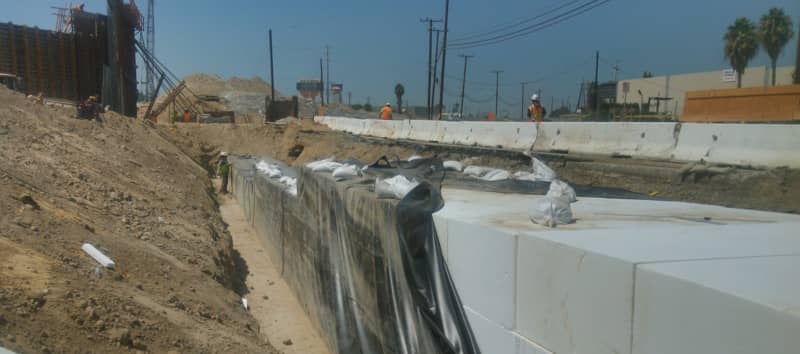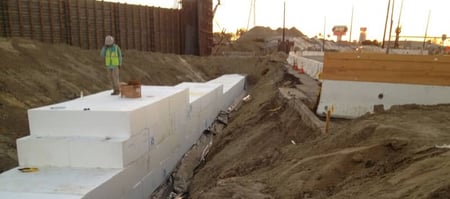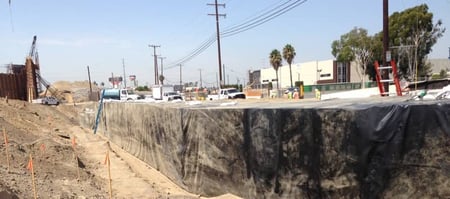
Every year, more and more roads and highways are constructed to meet growing demands. However, this new construction or expansion of infrastructure may end up being built over loose or soft soil that does not have the ability to support the associated loads.
So how do you reduce the vertical stress of these projects on the soil below? One solution is by using expanded polystyrene (EPS) geofoam blocks, or structural foam blocks.
What Are Geofoam Blocks
EPS geofoam is a lightweight foam plastic that's manufactured into blocks and commonly used as a structural geofoam backfill. EPS geofoam has a unit density that can be roughly as low as one pound per square foot. It's an extremely lightweight alternative to soil that's nearly 100 times lighter than most soils.
EPS geofoam blocks are primarily used in the construction of highways, bridges, embankments, and parking lots, but there are a myriad other uses as well. Due to the fact that geofoam is a soil replacement, it can be covered to look like a wall or a natural slope, making it an aesthetically pleasing option. The customizability of this material is also attractive since it can be cut into almost any size and shaped directly at the job site.
Reasons to Use Geofoam Blocks
- Made for project locations with weak soil
- Is perfect for projects with short timelines
- Costs less
- Provides soil frost protection
- Can contribute to LEED credit requirements
Geofoam Applications
- New highway and road construction
- Temporary road construction
- Bridge abutments
- Landslide areas with weak soil
- Artificial landscapes
- Retaining walls
- Railway track systems
- Airfield pavements
When choosing the correct geomembrane for geofoam road construction and other applications, you always need to consider the following six properties:
- Puncture strength/abrasion resistance
- Tensile strength
- Flexibility
- Vapor transmission
- Toughness
- Chemical resistance
Benefits of Geofoam Blocks
Besides being a lightweight alternative to soil, there are a number of lesser-known benefits of using geofoam, including its ability to:
- Accelerate construction
- Be constructed in adverse weather
- Be constructed and vertically faced in right-of-way scenarios
- Eliminate the need for heavy earthmoving equipment
- Provide overall project cost savings
- Reduce labor
- Reduce later loads from being exerted on retaining structures
- Help prevent slope failures
- Eliminate the need for environmental permits
 The above benefits have made EPS geofoam blocks an attractive alternative in this industry. The specification of EPS geofoam has seen an increase within the last few years, with some state Department of Transportation (DOT) administrators adding specification sheets for geofoam and geofoam coverage (otherwise known as geomembranes) to their agency documents. An example of this is CALTRANS in the state of California.
The above benefits have made EPS geofoam blocks an attractive alternative in this industry. The specification of EPS geofoam has seen an increase within the last few years, with some state Department of Transportation (DOT) administrators adding specification sheets for geofoam and geofoam coverage (otherwise known as geomembranes) to their agency documents. An example of this is CALTRANS in the state of California.
CALTRANS specifies that, in any application where geofoam is being used as a structural backfill, a reinforced gasoline-resistant geomembrane (GRG) must be used. The geomembrane must be able to protect the geofoam from spilled liquid hydrocarbons (like gasoline, diesel fuel, kerosene, etc.) as well as cover and conform to the corners of the EPS geofoam blocks at 45 degrees Fahrenheit, without heat being applied. An example of a geomembrane that passes the CALTRANS specifications is Seaman Corporation’s 9832 XR-5® G geomembrane.
While not all states have adopted the geofoam and geomembrane specifications, they are definitely on the rise. The geofoam global market is expected to reach USD 570 million by 2020.
Thinking of using geofoam blocks for your next project or know any other EPS geofoam benefits? Let us know in the comments!






